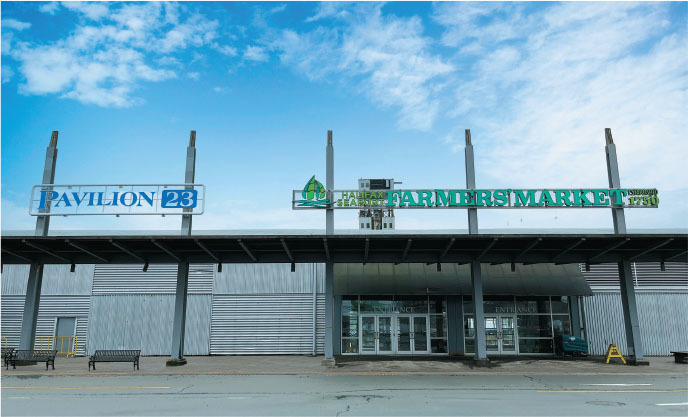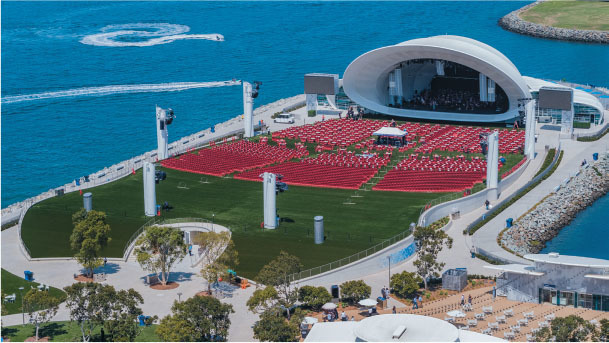 ISTOCK.COM/WILLIAM_POTTER
ISTOCK.COM/WILLIAM_POTTER
The all-eggs-in-one-basket strategy is rife with difficulties. Successful seaports are often highly diversified, and their revenue streams are too. Usually port revenues from usage fees or leases of land, equipment and other assets are derived from maritime trade and tourism, and related industries. Sometimes, they are not.
Ports don’t exist in a maritime vacuum. Indeed, if the COVID era has taught us anything, it is that we are all connected. Seaports partner with other modes. They are situated alongside various communities. They are served by labor and contractors, purveyors and utilities. They touch upon ecosystems and technologies and government.
Few individuals or organizations are unaffected by seaports. Is it any wonder then, that in their quest for financial security, and to address diverse goals, today’s seaports increasingly derive revenue from non-maritime, non-traditional sources?

Affiliated Sectors and Services
Affiliated sector and/or service revenue has become important to many ports. Just a few decades ago it was rare to find a line item for parking revenue on a balance sheet. Nowadays, ports with cruises or those near public-access facilities collect important revenue from parking. The Port of San Francisco, for example, received 10.6% of its 2021 revenue from parking sources, as reported in the port’s 2021 independent auditor’s report. In a non-COVID year that percentage is higher.
Some ports operate their own airports, bridges, tunnels, short rail lines or other modal interests. For example, the Port of New Orleans generates significant revenues from its New Orleans Public Belt Railroad Corporation, in addition to its cargo, cruise and industrial real estate operations, according to its 2022 Consolidated Financial and Operating Plan.

Most U.S. ports offer foreign-trade zone (FTZ) advantages to shippers. These facilities — which can be warehouses or yards, dry or refrigerated — are essentially cargo sites that the U.S. government considers as being outside of U.S. customs territory, despite a location within the borders of the United States. They help American companies improve trade and increase their competitiveness at the global level by allowing them to import, store, handle, manufacture or reconfigure and re-export under advantageous customs regulations.
While FTZs are considered a powerful mechanism to keep good jobs in the United States and to advance manufacturing, at PortMiami, the FTZ No. 281 also produces noteworthy revenues. For active sites, a flat annual fee of $6,500 is assessed and for non-active sites that drops to $2,500. In 2019, the port collected $305,000 in FTZ fees. That amount has risen each year to a total of $528,000 in 2022, according to spokesperson Freddy Pereira.
Community Engagement
Some of the more curious port revenue sources stem from port commitments to the communities within which they operate. The Halifax waterfront is home to the Halifax Farmers’ Market. The market is almost as old as the city itself. Created by Royal Proclamation in June of 1750, a year after the founding of Halifax, the market has operated in several locations across the city but moved to Halifax Seaport in 2010. It is now known as the Halifax Seaport Farmers’ Market — the longest continuously running market in North America.
Halifax Port Authority Communications Coordinator Emily Richardson said that the Halifax Seaport Farmer’s Market is a long-term commitment for the port. “The market recently completed its latest move into Pavilion 23 — a permanent and purpose-built location. The Halifax Port Authority is committed to maintaining an accessible public space that puts people first and showcases the best that Halifax has offer — from food and music to local vendors and hospitality,” said Richardson.
The commitment is by no means small. “The new space is approximately 18,000 square feet and features space for about 100 tables inside. There is overflow space outside of the building for vendors who prefer an open-air experience during the warmer months. Everything is located on one level, with plenty of space for farmers, artisans, prepared food vendors, and lots of available parking for customers,” said Richardson.
Maintaining a public space that is vibrant, accessible, financially sustainable, and welcoming to all is part and parcel of the port’s 50-year plan — one of its five overriding goals is to engage stakeholders and community.

At the Port of Benton, the 275-acre Crow Butte Park is located on a Columbia River island near Paterson, Washington. The U.S. Army Corps of Engineers created the island in the late 1970s as part of the McNary Dam project.
The Corps of Engineers transferred the park’s operations to the Port of Benton in 2007. “Throughout the years, the port has significantly improved Crow Butte Park and added amenities using grants, county and port funding,” according to Summers Miya, Port of Benton’s public information officer.
Crow Butte Island is culturally significant to local tribes and is considered a traditional cultural property due to its use as a winter village and fishing area. The port’s decision to invest in the park followed meetings with the Confederated Tribes of the Umatilla Indian Reservation, said Miya.
Today, Crow Butte Park has 50 fullservice campsites, a playground, a marina with three boat launches, as well as a sheltered bay for temporary moorage. The park is a favorite of boaters, water sports enthusiasts, hikers, anglers and families coming to picnic or spend the day by the river.
“Crow Butte Park helps support essential aspects of Port of Benton’s mission to generate jobs, strengthen the local and state economies and help increase tourism while enhancing the community’s quality of life,” said Miya.
While many ports’ community-based revenue sources generate small contributions, Crow Butte is on pace to generate $225,000 in revenue in 2022, according to Miya.
Some port-community collaborations have developed solely because of a port’s ownership of waterfront assets that are simply not available elsewhere. Unlikely to (and sometimes legally constrained from) relinquish ownership of highly desired, well-situated and often strikingly beautiful sites, ports often choose to lease them to community initiatives.
A new and already iconic west coast concert venue, The Rady Shell at Jacobs Park opened in the summer of 2021 along the picturesque San Diego Bay. Managed and programmed by the San Diego Symphony, and with more than 100 concerts and events year-round, the stunning venue is in one of the Port of San Diego’s many public parks. It has marina, bay, and downtown views and is within walking distance of many waterfront hotels and restaurants, the San Diego Convention Center, downtown businesses and attractions, Petco Park, and the historic Gaslamp District. In its first year, it was featured in an Apple iPhone release event, the New York Times called it “dazzling” and Forbes Magazine called it “the country’s coolest new concert venue,” according to a port spokesperson.

The Rady Shell at Jacobs Park is a result of a long-time civic desire to have a state-of-the-art concert venue on the bay that elevates the experience of live music, the spokesperson said. A side benefit of this venue is that 85% of the time it serves as a free public park for all of San Diego and its visitors to enjoy and access.
Rent to the port is based on a graduated percentage of gross sales and increases with greater use of the concert venue. Currently, revenue to the port is $100,000 per year.
The spokesperson said that the Port of San Diego relies on revenue from tenants rather than on tax revenue, and that earnings from waterfront businesses and attractions like The Rady Shell at Jacobs Park go right back into the community through the upkeep and maintenance of waterfront public amenities and facilities for the enjoyment of San Diego Bay visitors.
In the Works
While some atypical revenue sources generate funds immediately, some take a while to brew.
The Port of Corpus Christi and Buckeye Partners, L.P., announced their intention in August 2022 to establish an 81,000-plus panel solar farm in Coastal Bend on 136.7 acres of Port of Corpus Christi property.
“This partnership is the latest initiative undertaken by the Port of Corpus Christi in its bullish drive to lead the global market into the energy renaissance, rendering renewable energy a legitimate and sustainable commodity,” according to the port’s news release. The lease agreement provides Buckeye with a two-year term to evaluate feasibility. Expectations are, once the project expands onto 112 adjacent acres owned by Buckeye, the farm will have the capacity to produce 88,000 MWh of electricity per year. Commercial operations of the solar farm are tentatively scheduled to begin in Q4 2025.
A successful solar installation/operation accomplish a great deal for the port. In addition to serving as a future revenue source, it reinforces the port’s commitment to embrace renewable energy developments, solidifies the port as a thought leader in the global energy marketplace, and marks the expansion into a new chapter for the Port of Corpus Christi, according CEO Sean Strawbridge.

The American Association of Port Authorities just announced its Port Opportunities with Energy, Resilience and Sustainability (POWERS) Program. Aiming to meet “the twin challenges of energy security and climate change”, the initiative advocates for federal policies to support American energy prowess, pragmatic decarbonization, technology for renewables, and environmental sustainability. (Learn more on page 32.)
Port developments like the Corpus Christi solar farm align well with the industry’s goal of enhancing electric infrastructure at ports. If ports can help in the pursuit of cleaner air and cleaner communities, while generating revenue, it is a win-win for all.
Atypical Revenue
As ports work to better serve the integrated supply chain needs of customers, and as they endeavor to better align their goals with those of all of their stakeholders, especially communities, they take on new initiatives. Some of these are simply a cost item for the port. Nevertheless, in many cases, ports have been able to generate modest or even remarkable levels of revenues from non-maritime services, parks, entertainment venues, non-traditional leases, and other exploits.
Many ports with unusual revenue sources report side benefits related to conventional port goals, such as enriching community engagement, customer service and sustainability. Long-term planning that seeks to unearth new sources of revenues can end up taking a detour into previously unknown riches.
 AAPA Seaports
AAPA Seaports


